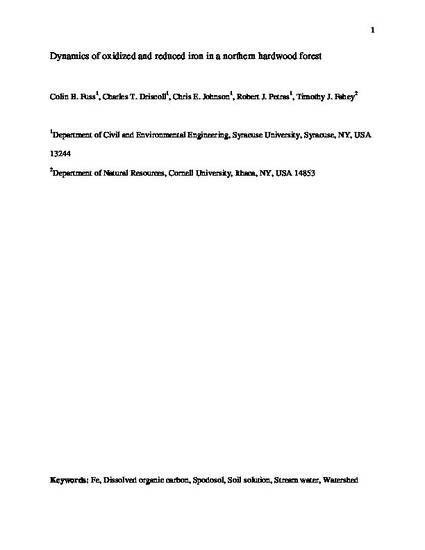
- Fe,
- Dissolved organic carbon,
- Spodosol,
- Soil solution,
- Stream water,
- Watershed
Iron (Fe) is ubiquitous in forest ecosystems and its cycle is thought to influence the development of soil, particularly Spodosols (podsolization), and the biogeochemistry of macronutrients such as carbon (C), nitrogen (N), and phosphorus (P), as well as many trace metals. The cycle of Fe in northern hardwood forests remains poorly understood. To address some of these uncertainties, we constructed a biogeochemical budget of Fe for a small catchment at the Hubbard Brook Experimental Forest in the White Mountains of New Hampshire, USA. Horizonal, temporal, and elevational patterns of concentrations and fluxes of oxidized and reduced Fe species were assessed in leaf litter, soil, soil solution, and stream water. The chemistry of dissolved Fe was evaluated in the context of its relationship with dissolved organic carbon, pH, and dissolved oxygen. Soil solution fluxes of Fe were highest in the organic (Oa, 52.5 mol ha−1 year−1) horizon and decreased with depth in the mineral (Bh, 50.5 mol ha−1 year−1, and Bs, 19.7 mol ha−1 year−1) horizons, consistent with podsolization theories predicting immobilization of Fe following downward transport to mineral soils. The export of Fe in stream water (1.8 mol ha−1 year−1) was lower than precipitation input (3.5 mol ha−1 year−1). The low stream flux indicates most Fe in drainage waters was immobilized in the soil and retained in the watershed. The portion of total Fe as Fe(II) was ~10–60% in soil solutions, seemingly high for soils that are considered to be well-drained, oxidizing environments. Organic complexes likely stabilized Fe(II) in solution under oxidizing conditions that would otherwise promote considerably higher Fe(III)-to-Fe(II) ratios. Our study indicates that there are organic matter-derived sources of dissolved Fe(II) as well as substantial mobilization of Fe(II), possibly the result of the reduction of Fe-bearing soil minerals.
